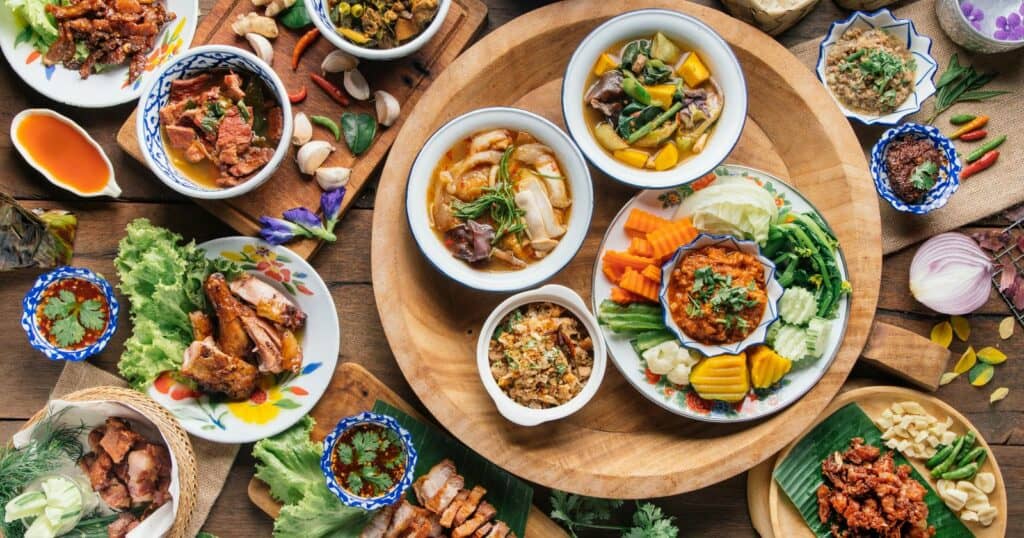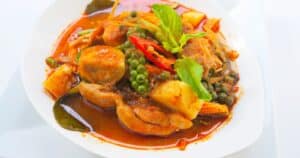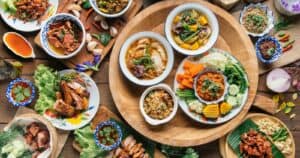Thai cuisine seems to come with a high price tag at certain restaurants, even though it’s known for affordable street eats. So why exactly can Thai food get so expensive?
The rising popularity of Thai food worldwide drives demand at restaurants abroad. To recreate complex authentic flavors, these establishments must import specialty ingredients not found locally. In addition, expert Thai chefs command higher salaries to execute tricky cooking techniques. Elaborate decor and translations also raise costs.
In touristy areas, hype allows some Thai restaurants to overprice dishes. However, finding affordable Thai food is possible by picking family-run eateries off the beaten path. Lunch specials, takeout and food trucks lower prices too. So with insider tips, you can still taste amazing authentic Thai cuisine on a budget!
The rest of this post explores factors making Thai food expensive in-depth. You’ll also get pro tips for seeking out wallet-friendly Thai meals…
The Rising Popularity of Thai Cuisine

Part of the reason Thai restaurants may charge higher prices is the cuisine’s tremendous popularity worldwide. Thai food tantalizes taste buds with its harmonious blend of sweet, sour, salty and spicy flavors. The infusion of Chinese, Indian and Malay cooking methods and ingredients creates a unique and diverse culinary experience.
In addition, Thai dishes often feature an array of colorful vegetables, seafood, herbs and spices. This combination provides not only bold tastes but also valuable nutrients. No wonder Thai cuisine has gained legions of fans globally!
Key Factors Driving Up Costs
Several key factors contribute to the higher cost of Thai cuisine at certain establishments:
Importing Authentic Ingredients
To create genuine Thai flavors, restaurants abroad need to import specialty herbs, spices and produce not readily available locally. Flying in galangal, lemongrass and other staples from Thailand adds expenses.
Labor-Intensive Cooking Techniques
Mastering complex Thai cooking methods takes time and skill. The intricacy involved in achieving perfect balance and textures may demand knowledgeable (and costlier) chefs.
High Demand
Thai food’s immense popularity worldwide means some restaurants can capitalize on their reputation and high demand by charging premium prices.
Lavish Decor
Many Thai restaurants strive for extra-authentic ambiance with costly decor, tableware and entertainment, which hike up the total bill.
Translation Needs
To serve diverse diners, some establishments hire translators or provide menus in multiple languages, increasing operating costs.
Local Economic Factors
In places with high rents and living costs, Thai eateries charge more to cover expenses while remaining profitable.
So in summary, importing ingredients, labor costs, popularity, decor, translations and local economics all play a role in Thai cuisine’s price tag abroad.
The Cost of Running a Thai Restaurant Abroad
From licensing fees to rent, Thai restaurants overseas rack up high operating expenses. Many smaller mom-and-pop restaurants struggle to stay afloat. Higher menu prices help keep the lights on.
Importing ingredients, hiring trained chefs, and creating an authentic atmosphere all contribute to overhead for Thai restaurants abroad. But day-to-day costs add up too.
Rent and utilities in prime dining locations command top dollar. Local business permits, licenses and fees can also be pricey. Plus specialized Thai ingredients and spices rarely come cheap.
On top of that, restaurants must pay cooks, servers, managers, and other staff a living wage. And marketing is crucial for spreading awareness and competing with other eateries.
With slim profit margins in the restaurant industry, and unique costs associated with running a Thai establishment overseas, higher menu prices are often necessary. So next time sticker shock sets in, consider the big picture behind making your favorite dishes possible outside of Thailand!
How Thai Immigrants Influenced Thai Food’s Rise
Thai immigrants in the 1960s and 70s were instrumental in spreading Thai cuisine in the West. As Thai communities grew in the U.S., so did the presence of Thai restaurants.
Many establishments are family-owned and pass down recipes through generations, maintaining authenticity. Thai restaurateurs have also adapted flavors to suit American palates. For instance, pad thai uses ketchup instead of tamarind to be less tangy.
In addition, the bold seasonings of Thai food tantalize those seeking intense new flavors beyond the familiar. And with an emphasis on fresh herbs, veggies and lean proteins, Thai cuisine has a reputation as a healthy choice.
The adaptability, intense spices, fresh components and family-run authenticity among Thai immigrant restaurants have made Thai food more accessible and irresistible.
Affordable Thai Cuisine in Thailand
When it comes to Thai food prices in Thailand itself, meals can cost as little as a dollar or two. Exact prices vary enormously based on factors like:
- Location – Rural spots are cheaper than Bangkok.
- Restaurant Type – Street stalls and food courts are budget-friendly.
- Dishes Ordered – Noodle and rice plates are inexpensive.
Here are some sample prices, converted to U.S. dollars:
- Basic rice/curry meal: $1-2
- Western-style plate with soda: $1.30-$2.30
- Upscale dinner for two: $16
- Street food like grilled chicken over rice: $0.70
- Shopping mall food court lunch: $1.30-$1.70
So savory Thai food in its homeland remains highly affordable, especially from street vendors and simple eateries. Tourists can eat very cheaply!
10 Tips for Affordable Authenticity
You can discover budget-friendly and genuine Thai cuisine even in Western restaurants. Here are some tips:
1. Choose Local Eateries
Seek out family-run establishments off the main tourist track for authentic recipes and prices.
2. Check Prices in Advance
Scan menus online to find restaurants offering good value for your money.
3. Ask Locals for Recommendations
Local expertise leads to hidden gems not in guidebooks.
4. Avoid Tourist Traps
Skip high-cost spots catering to visitors for a more authentic vibe.
5. Take a Food Tour
An expert guide will show you to genuine and modestly priced local restaurants.
6. Check the Lunch Menu
Many restaurants offer lunch specials with smaller portions at lower prices.
7. Go for Noodle Dishes
Thai noodle plates like pad thai and pad see ew are often cheaper than more elaborate entrees.
8. Seek Out Food Trucks
Mobile Thai kitchens boast tasty eats without the overhead of a brick-and-mortar location.
9. Visit Asian Markets
Grocery store takeout counters sell homemade style Thai curries, noodles and stir-fries at wallet-friendly rates.
10. Make it at Home
Prepare your own quick and easy Thai staples like fried rice using supermarket ingredients.
By picking local spots, scoping prices ahead, asking around, avoiding tourist-oriented locations and taking food tours, you can discover authentic and affordable Thai cuisine.
How Home Cooking Can Satisfy Your Thai Craving
With some basic pantry spices like chili flakes, fish sauce, lime and cilantro, plus chicken or tofu, you can whip up quick, delicious Thai staples at home for a fraction of restaurant prices.
Keep coconut milk, rice noodles and Thai curry paste handy to assemble classic dishes like pad thai, drunken noodles or panang curry with little effort. Frozen veggies like peas and carrots also work great.
Flank steak can be tossed in a homemade Thai marinade, then quickly grilled or stir-fried for a tasty weeknight meal. And Soup bases simmered with mushrooms, spinach and red curry paste make simple, aromatic Thai soups.
With a stocked pantry, go-to proteins, veggies and grains, plus some simple recipes, you can recreate vibrant Thai flavors easily and affordably at home. Satisfy those Thai food cravings without paying restaurant premiums!





